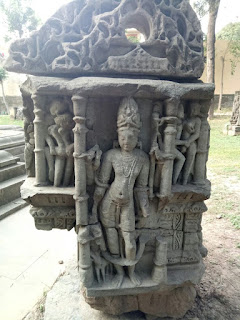First On-Site Visit : Bhima Devi Temple, Pinjore by Priyanshu Mehta
What comes to your mind when I talk of an Archaeological recording workshop? A formal site visit led by a regimented Task In-charge? If yes, then let me help you get rid of this preconception. Because the Speaking Archaeologically site visits are nothing like that.
On the fine Sunday morning of 15th October, I embarked on the bus journey from Chandigarh to Pinjore. Though I had visited the place before, but never knew there was a temple too.
Anyway, it was a 45 minute long journey and I spent the whole time trying to wrap up the essay we had to submit the same day.
I reached there by noon as we all were supposed to, where Shriya greeted us all warmly (See, what did I say? No formalities).
We walked further, got onto the site, had a session on Hindu temples and conferred about them in detail. Studied Hinduism in its primary form, discussed Tantra, Mantra and Yantra, familiarized ourselves with different Gods, including the one pictured below. That's Ishana (Moon) who had 28 wives but he only loved one which eventually got him into trouble. That's kind of strange but fascinating too. Well, why he had 28 wives and what was the trouble is another interesting story that you should know but I won't be discussing it here.
From mythological beliefs to rationality, we pieced it all together and learnt some baffling facts about temples and the Hindu religion, for instance Hindu temples are housed in the body of a seated woman. Did you know that? Interesting, right?
As the session ended I drew two important conclusions. One, we have a vast cultural heritage. Two, I know nothing about it.
After studying the site we moved on to the Mapping. Shriya gave us a brief overview of the mapping technique and divided us into two teams, of four each. We were asked to draw the site plan and plot it on the graph.
As the one penning this blog post was on the winning team, let me tell you what builds a great team. Nothing—absolutely nothing—pulls a team together or strengthens their bond like FOOD. It promotes the feeling that says "I must do my very best". And as Shriya said "The team who submits the plan first would be rewarded with free food", we plunged into our work. Though we ran out of time, still somehow managed to pull it off and won the task. Here is the final site plan I made.
The site visit ended as we satiated our appetite and conversed about Ethno-archaeology and how the materialistic remains give us an insight into the history of a place.
And, yes! One more good thing about the visit, we got extension on the essay I talked about in the starting.
All in all, it was an informative site visit and we avidly await more such workshops.
On the fine Sunday morning of 15th October, I embarked on the bus journey from Chandigarh to Pinjore. Though I had visited the place before, but never knew there was a temple too.
Anyway, it was a 45 minute long journey and I spent the whole time trying to wrap up the essay we had to submit the same day.
I reached there by noon as we all were supposed to, where Shriya greeted us all warmly (See, what did I say? No formalities).
We walked further, got onto the site, had a session on Hindu temples and conferred about them in detail. Studied Hinduism in its primary form, discussed Tantra, Mantra and Yantra, familiarized ourselves with different Gods, including the one pictured below. That's Ishana (Moon) who had 28 wives but he only loved one which eventually got him into trouble. That's kind of strange but fascinating too. Well, why he had 28 wives and what was the trouble is another interesting story that you should know but I won't be discussing it here.
From mythological beliefs to rationality, we pieced it all together and learnt some baffling facts about temples and the Hindu religion, for instance Hindu temples are housed in the body of a seated woman. Did you know that? Interesting, right?
As the session ended I drew two important conclusions. One, we have a vast cultural heritage. Two, I know nothing about it.
After studying the site we moved on to the Mapping. Shriya gave us a brief overview of the mapping technique and divided us into two teams, of four each. We were asked to draw the site plan and plot it on the graph.
The site visit ended as we satiated our appetite and conversed about Ethno-archaeology and how the materialistic remains give us an insight into the history of a place.
And, yes! One more good thing about the visit, we got extension on the essay I talked about in the starting.
All in all, it was an informative site visit and we avidly await more such workshops.







Comments
Post a Comment